Evacuations ordered in South America as worst tsunami risk passes for US, Japan
By Jennifer Sinco Kelleher and Audrey Mcavoy
Honolulu: Fears of a devastating tsunami faded on Wednesday for the US and Japan after one of the strongest earthquakes ever recorded struck off a sparsely populated Russian peninsula, but communities along South America’s Pacific coast carried out evacuations and closed beaches.
Warnings in the first hours after the 8.8 magnitude quake sent residents fleeing to rooftops in Japan, where one person died and 10 were injured, and forced tourists out of beachfront hotels in Hawaii, snarling island traffic. In Russia, several people were hurt rushing to get out of buildings, including a hospital patient who jumped from a window.
Millions of people were told to move away from the shore or seek high ground because they were potentially in the path of the tsunami waves, which struck seaside areas of Japan, Hawaii and the US West Coast but did not appear to cause any major damage.
The dire warnings following the massive quake early Wednesday off Russia’s Kamchatka peninsula evoked memories of catastrophic damage caused by tsunamis over the last quarter-century.
In Japan, people flocked to evacuation centres, hilltop parks and rooftops in towns on the Pacific coast with fresh memories of the 2011 earthquake and tsunami that caused a nuclear disaster.
Cars jammed streets and highways in Honolulu, with standstill traffic even in areas away from the sea.
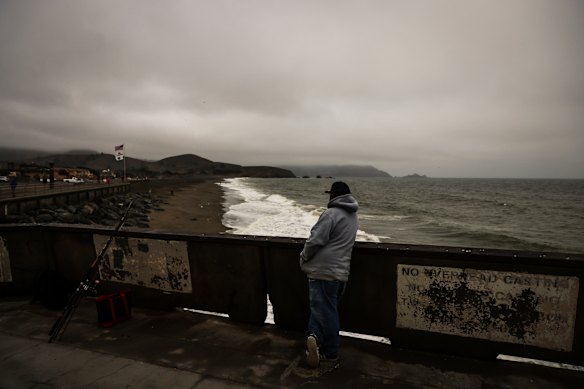
A fisherman looks out at the beach where a tsunami advisory was in effect in Pacifica, California.Credit: AP
“We’ve got water, we got some snacks ... we’re going to stay elevated,” said Jimmy Markowski, whose family from Hot Springs, Arkansas, fled their Waikiki beach resort before evacuation orders were lifted. “This is our first tsunami warning ever. So this is all new to us.”
US Secretary of Homeland Security Kristi Noem said the worst was over. Later on Wednesday, tsunami advisories for Hawaii, Alaska, Oregon and Washington state were cancelled, but remained for parts of northern California, where authorities warned to stay away from beaches and advised that dangerous currents should be expected through Thursday morning.
Experts say it’s challenging to know when to drop advisories, which signal the potential for strong currents, dangerous waves and flooding.
“It’s kind of hard to predict because this is such an impactful event and has created so many of these waves passing by,” said Dave Snider, tsunami warning coordinator for the National Tsunami Warning Centre in Alaska.
Among strongest quakes ever recorded
The earthquake appeared to be the strongest recorded since the 9.0 magnitude earthquake off north-eastern Japan in March 2011, which caused a massive tsunami and set off meltdowns at a nuclear power plant. The International Atomic Energy Agency said initial reports showed Japan’s nuclear plants were not affected.
Wednesday’s quake occurred along the “Ring of Fire,” a series of seismic faults around the Pacific Ocean. It was centred offshore, about 120 kilometres from Petropavlovsk-Kamchatsky, Kamchatka’s regional capital. Multiple aftershocks as strong as 6.9 magnitude followed.
Russia’s Oceanology Institute said tsunami waves of less than six metres were recorded near populated areas of the peninsula.
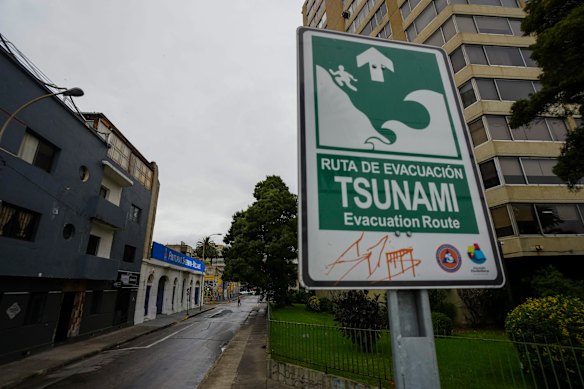
An evacuation route sign, in case of a tsunami, stands in Valparaiso, Chile.Credit: AP
Lava began flowing on Wednesday from the Northern Hemisphere’s largest volcano in a remote area of Kamchatka, the Russian Academy of Sciences’ geophysical service said.
Evacuations ordered in South America
In South America, three of the four countries with coastlines on the Pacific lifted their tsunami warnings.
Authorities in Colombia, Ecuador and Peru announced that tsunami alerts were removed. In Chile, the country with the largest Pacific coastline in South America, the government kept the alert along most of the coastline but lifted it in some areas where authorities said there was no longer a risk.
Chile’s Interior Minister, Álvaro Elizalde, said late on Wednesday that evacuation orders remained in force in areas with alerts in place, and that schools would be closed again on Thursday.
He said a wave in one location measured 2.5 metres, while in other areas waves reached 1.1 metres.
Chile is highly vulnerable to earthquakes and tsunamis.
Authorities in New Zealand, the Philippines and Mexico warned residents to watch for waves and strong currents.
NZ officials said rebounding tsunami activity from South America meant that strong and unusual currents could continue for another 24 hours. While evacuations had not been ordered, people have been warned to stay out of the water and away from beaches, shorelines, harbours, rivers and estuaries.
People were also urged to stay away from coastlines until any wave surges passed in Fiji, Samoa, Tonga, Federated States of Micronesia and Solomon Islands.
Russian surgeons keep steady hands despite quake shakes
A team of medics was in the middle of surgery in Petropavlovsk-Kamchatsky when the earthquake shook their equipment and the floor beneath them.
The medics used their hands to try to steady both the patient and their equipment, CCTV footage released by the Kamchatka region’s Health Ministry showed.
“Despite the danger, the doctors remained calm and stayed with the patient until the very end,” Oleg Melnikov, the minister, wrote on Telegram. He gave no details of the surgery but added that the patient was currently out of danger.
Russian regions report limited damage
Kremlin spokesman Dmitry Peskov said there had been no casualties in Russia from the quake, crediting solid building construction and the smooth working of alert systems.
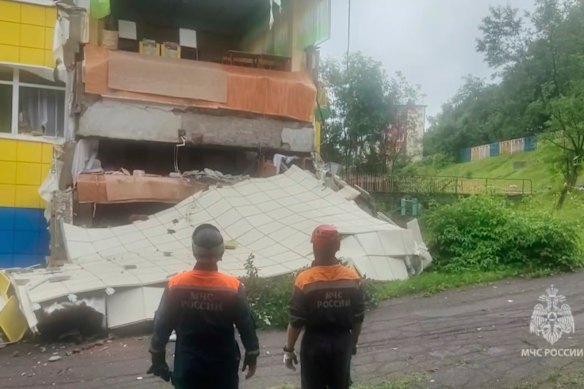
Rescuers inspect a kindergarten damaged by an earthquake in Petropavlovsk-Kamchatsky, Russia.Credit: AP
Still, there were scenes of chaos along Russia’s remote and sparsely populated Far Eastern seaboard, and scattered reports of damage.
Roman Kripakov, a chef in Severo-Kurilsk on Paramushir, one of the Pacific Kuril Islands chain, said he was at the cafe where he works when it began to shake.
“We ran out onto the street, and saw that all the buildings were trembling. Pipes, bricks, they were all falling down from the roofs,” he told Reuters.
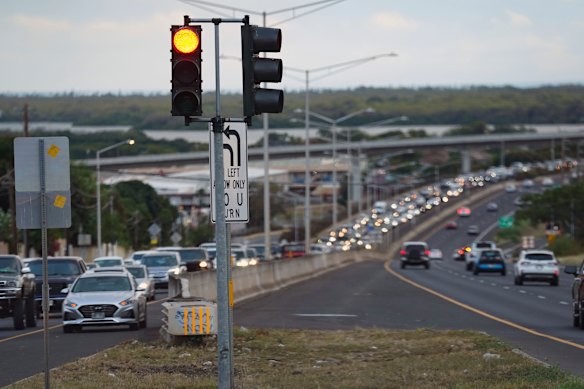
Oahu residents evacuating Ewa Beach due to the threat of tsunami in Kapolei, Oahu, Hawaii.Credit: AP
“Did I think about death? Yes, it did come to mind. I asked everyone for forgiveness, and recalled happy moments in my life. I wrote to my wife.”
In Petropavlovsk-Kamchatsky, the quake damaged a local kindergarten that was unoccupied.
Authorities on the sparsely Kuril Islands reported several waves flooded the fishing port of Severo-Kurilsk, the main city on the islands, and cut power supplies to the area. The port’s mayor said no major damage was recorded.
Hawaii downgrades to tsunami advisory
Authorities in Hawaii downgraded the state to a tsunami advisory early on Wednesday, and evacuation orders on the Big Island and Oahu, the most populated island, were lifted.
An advisory means there is the potential for strong currents and dangerous waves, as well as flooding on beaches or in harbours.
“As you return home, still stay off the beach and stay out of the water,” said James Barros, administrator of the Hawaii Emergency Management Agency.
In northern California, tsunami activity continued to build Wednesday morning, with maximum confirmed heights along the coast of 1.1 metres in Crescent City, which has a history of tsunami disasters. Even waves of just several feet high might pose a significant risk.
“It might only be 3 feet, but it’s a wall of water that’s 3 feet and spans hundreds of miles. Three feet of water can easily ... flood a couple blocks inland from the beach,” said Diego Melgar, director of Cascadia Region Earthquake Science Centre at the University of Oregon.
Dozens find refuge on hilltops, rooftops in Japan
A tsunami of 60cm was recorded in Hamanaka town in Hokkaido and Kuji port in Iwate, according to the Japan Meteorological Agency. Chief Cabinet Secretary Yoshimasa Hayashi said a woman in her 50s died after falling from a cliffside road while driving to an evacuation centre. Ten others – most of them in Hokkaido – were injured while heading to shelter.
In Iwaki city in Fukushima, which was the epicentre of the 2011 tsunami and quake, dozens of residents gathered at a hilltop park after a community siren sounded and breakwater gates were closed.
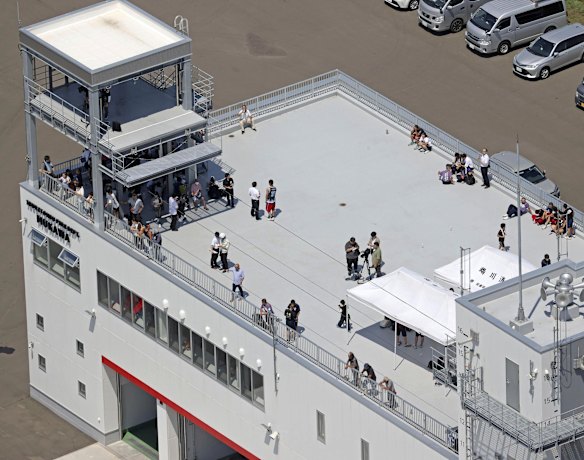
People take shelter on the roof of a fire station in Mukawa town, Hokkaido, northern Japan after a powerful earthquake in Russia’s Far East prompted tsunami alert in parts of Japan.Credit: AP
Workers at the Fukushima Daiichi nuclear plant, severely damaged in 2011, took shelter on higher ground while remotely monitoring operations, the operator said.
By late Wednesday, Japan had downgraded its tsunami alert but left an advisory in place along the Pacific coast.
AP, Reuters
Get a note directly from our foreign correspondents on what’s making headlines around the world. Sign up for our weekly What in the World newsletter.